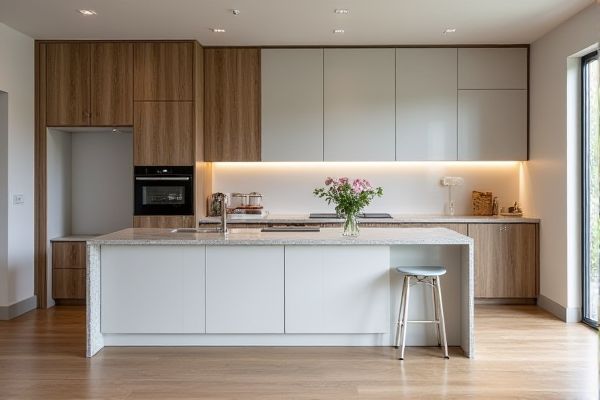
Waterproof cabinets provide a complete seal that prevents any water penetration, making them ideal for areas with high moisture exposure, while water-resistant cabinets can withstand minor splashes and humidity but are not impervious to prolonged water contact. Understanding the specific benefits and limitations of each type will help you choose the best option for your space--read on to discover which cabinet protection suits your needs.
Table of Comparison
| Feature | Waterproof Cabinets | Water-Resistant Cabinets |
|---|---|---|
| Definition | Completely sealed to prevent water ingress | Resist water penetration but not fully sealed |
| Protection Level | 100% waterproof, suitable for submersion or heavy water exposure | Protected against splashes and light moisture |
| Material | High-grade plastics, sealed metals, waterproof coatings | Water-resistant wood, treated metals, water-repellent finishes |
| Typical Use Cases | Outdoor electrical equipment, marine use, flood-prone areas | Bathrooms, kitchens, light outdoor exposure |
| Cost | Higher due to superior sealing and materials | Generally lower, designed for moderate protection |
| Durability | Long-lasting under wet conditions | Durable but may degrade with prolonged water exposure |
| Maintenance | Minimal, often self-sealing | Requires periodic inspection and refinishing |
| Examples | IP68-rated electrical enclosures, marine-grade cabinets | Bathroom vanity cabinets, kitchen storage units |
Understanding Waterproof vs. Water-Resistant Cabinets
Waterproof cabinets provide complete protection against water penetration, making them ideal for environments prone to heavy moisture or direct water exposure, such as bathrooms and outdoor spaces. Water-resistant cabinets, on the other hand, are designed to resist minor moisture and splashes but may not withstand prolonged exposure to water, often suited for kitchens or areas with occasional humidity. Choosing between waterproof and water-resistant cabinets depends on the specific moisture levels in the intended space and the required durability of the cabinet materials.
Key Materials Used in Cabinet Construction
Waterproof cabinets are typically constructed using non-porous materials such as high-density polyethylene (HDPE) or marine-grade plywood coated with waterproof sealants, ensuring complete water impermeability. Water-resistant cabinets often utilize materials like medium-density fiberboard (MDF) treated with water-repellent laminates or veneers that provide limited protection against moisture. Your choice between these will depend on the level of exposure to water, as waterproof materials offer superior durability in wet environments compared to water-resistant options.
Performance in Moisture-Prone Areas
Waterproof cabinets provide complete protection against water infiltration, making them ideal for moisture-prone areas such as bathrooms, laundry rooms, or outdoor spaces, where exposure to water is frequent and intense. Water-resistant cabinets can withstand occasional splashes or humidity but may degrade over time if consistently exposed to heavy moisture or water. Your choice of cabinet should depend on the level of water exposure expected, with waterproof options offering superior durability and performance in wet environments.
Durability and Lifespan Comparison
Waterproof cabinets offer superior durability and a longer lifespan compared to water-resistant cabinets due to their ability to withstand complete water exposure without damage. Water-resistant cabinets can resist moisture and minor spills but may degrade over time with prolonged exposure to water, leading to swelling, warping, or mold. Choosing waterproof cabinets ensures your storage solutions maintain structural integrity and aesthetic appeal even in high-humidity or wet environments.
Design Options and Aesthetic Flexibility
Waterproof cabinets offer a broader range of design options and aesthetic flexibility due to their sealed construction, allowing use in high-moisture environments without compromising style. Water-resistant cabinets, while limited in moisture protection, provide various finishes and materials suitable for areas with occasional dampness, balancing appearance with moderate durability. Choosing the right option ensures your space maintains both functionality and visual appeal based on moisture exposure.
Cost Differences Explained
Waterproof cabinets typically cost more than water-resistant cabinets due to advanced materials and sealing technologies that prevent water intrusion completely. Water-resistant cabinets offer moderate protection using water-repellent coatings and materials, making them a budget-friendly option suitable for less moisture-prone areas. Your choice depends on the level of exposure, with waterproof cabinets providing long-term durability in high-humidity or flood-prone environments, justifying the higher initial investment.
Installation Requirements and Challenges
Waterproof cabinets demand precise sealing techniques and moisture barriers during installation to ensure complete protection from water ingress, often requiring professional expertise and specialized materials. Water-resistant cabinets are easier to install with standard sealing practices, but they still need careful attention to joints and edges to prevent water damage in humid environments. Both types face challenges related to maintaining integrity over time, especially in areas prone to high moisture or direct water exposure.
Maintenance and Cleaning Needs
Waterproof cabinets require minimal maintenance due to their sealed surfaces that prevent water infiltration, reducing the risk of mold and material deterioration. Water-resistant cabinets need more frequent inspections and cleaning to address potential moisture seepage that can cause swelling or damage over time. Regular wiping with non-abrasive cleaners ensures longevity for both types but is especially critical for maintaining the integrity of water-resistant cabinetry.
Ideal Applications for Each Cabinet Type
Waterproof cabinets are ideal for high-moisture environments such as bathrooms, kitchens, and outdoor settings where complete protection against water intrusion is essential. Water-resistant cabinets suit areas with occasional splashes or humidity fluctuations like laundry rooms and basements, offering sufficient defense without the need for full waterproofing. Choosing the appropriate cabinet type depends on the level of exposure to water and the requirement for long-term durability against moisture damage.
Making the Right Choice for Your Space
Waterproof cabinets provide complete protection against moisture, ideal for high-humidity environments like bathrooms or outdoor kitchens, whereas water-resistant cabinets offer only limited moisture defense suitable for areas with occasional splashes. Selecting the right cabinet depends on the room's moisture levels, frequency of water exposure, and budget constraints, ensuring durability and long-term performance. Investing in waterproof options typically results in greater longevity and less maintenance in moisture-prone spaces compared to water-resistant models.
 homyna.com
homyna.com